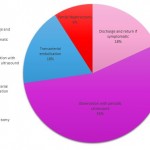RE: In patients with a previous negative prostate biopsy and a suspicious lesion on magnetic resonance imaging, is a 12-core biopsy still necessary in addition to a targeted biopsy?
Sir,
We read with much interest the work of Salami [1], which strengthens the evidence in favour of a mpMRI targeted biopsy (TBx) in the diagnostic work-up of patients with persistent clinical suspicion of prostate cancer (PCa). TBx can indeed improve the detection rate of prostate biopsy without the need of a systematic sampling, especially in presence of previous negative histological findings [2]. TBx might also reduce the risk of biopsy-related complications, as much as improve patient quality of life, focusing only on suspicious mpMRI targets. Thanks to the high negative predictive value of mpMRI [2], patients with persistently high PSA could even avoid the re-biopsy, in presence of a negative mpMRI. In this light, probably TBx should be implemented by current guidelines in the re-biopsy setting not only as a ‘’possible option’’, but as a recommendation.
But is it really safe to avoid random biopsies and restrict to index lesion targeting? According to recent evidence, systematic sampling does not significantly improve the detection rate, at least in terms of clinically significant PCa [2, 3]. A recent trial published on JAMA deposed against systematic sampling, showing that 17 low-risk diagnoses are needed to find a high-risk PCa by adding systematic sampling to TBx [3]. The added value of this trial was that the urologist performing systematic biopsies was blinded to mpMRI. In the study by Salami, instead, random sampling was “cognitive”, as the urologist knew the location of the lesions at mpMRI, possibly causing a falsely higher detection rate of standard biopsies. These findings confirm that the space for random biopsies is narrowing, as compared to TBx.
Although mpMRI has achieved an important role in early PCa detection, several issues still need to be investigated to reach a complete understanding of its diagnostic potential. First, the heterogeneity in MRI technical features and imaging analyses possibly hamper the comparison of mpMRI outcomes and its generalization to clinical practice [4]. Secondly, the variability in the assessment of PCa clinical significance represents another bias, considering that mpMRI series usually use biopsies as terms of comparison to assess mpMRI accuracy, instead of radical prostatectomy specimens. This is an important limitation, as Gleason score upgrading from biopsy to radical prostatectomy has been reported in about 30% of patients [5], changing the rules of risk attribution. No consensus has been reached about the definition itself of PCa clinical significance. Thirdly, further evidence is required to assess the number of cores that need to be taken for TBx in order to obtain a reliable sampling. A final aspect to be considered involves the possibility of procedural errors and a certain degree of mpMRI inaccuracy, as shown by some significant PCa detected in spite of a negative TBx [1]. We are confident, though, that some of this inaccuracy will disappear with the progression in the learning curve, both on urological and radiological sides.
Although the evidence on mpMRI and TBx is increasing, further studies are advised to shed light on these aspects that remain not fully understood, before giving a final recommendation on this topic.
Marco Oderda, Giancarlo Marra, Paolo Gontero
Department of Urology, San Giovanni Battista Hospital, University of Turin, Città della Salute e della Scienza, Turin, Italy
Source of Funding: Giancarlo Marra is funded by the Fondazione di Ricerca Molinette Onlus
Conflict of Interest: None.
References
[1] Salami SS, Ben-Levi E, Yaskiv O, et al. In patients with a previous negative prostate biopsy and a suspicious lesion on magnetic resonance imaging, is a 12-core biopsy still necessary in addition to a targeted biopsy? BJU international. 2015 Apr: 115:562-70
[2] Schoots IG, Roobol MJ, Nieboer D, Bangma CH, Steyerberg EW, Hunink MG. Magnetic Resonance Imaging-targeted Biopsy May Enhance the Diagnostic Accuracy of Significant Prostate Cancer Detection Compared to Standard Transrectal Ultrasound-guided Biopsy: A Systematic Review and Meta-analysis. European urology. 2014 Dec 2:
[3] Siddiqui MM, Rais-Bahrami S, Turkbey B, et al. Comparison of MR/ultrasound fusion-guided biopsy with ultrasound-guided biopsy for the diagnosis of prostate cancer. Jama. 2015 Jan 27: 313:390-7
[4] Futterer JJ, Briganti A, De Visschere P, et al. Can Clinically Significant Prostate Cancer Be Detected with Multiparametric Magnetic Resonance Imaging? A Systematic Review of the Literature. European urology. 2015 Feb 2:
[5] Cohen MS, Hanley RS, Kurteva T, et al. Comparing the Gleason prostate biopsy and Gleason prostatectomy grading system: the Lahey Clinic Medical Center experience and an international meta-analysis. European urology. 2008 Aug: 54:371-81



Sir,
We appreciate the comment of Oderda et al on our article titled “In patients with a previous negative prostate biopsy and a suspicious lesion on MRI, is a 12-core biopsy still necessary in addition to a targeted biopsy?”1 The authors agreed with our finding that, multiparametric MRI (MP-MRI) of the prostate with fusion biopsy of suspicious lesions improved the detection of clinically significant prostate cancer (CaP) compared with standard 12-core biopsy. Although the use of MP-MRI in the screening and detection of prostate cancer is yet to be adopted by the entire urology community, we have compelling evidence to suggest that it should be recommended and introduced in the algorithm for the evaluation of men with previous negative biopsies.
The National Institute for Health and Care Excellence (NICE; UK), crucially evaluated the use of PCA3 assay, Prostate Health Index, and MP-MRI in patients with prior negative biopsies. Their evaluation resulted in the recommendation of only utilizing MP-MRI in screening patients with history of a prior negative prostate biopsy and if the MRI is negative obviating other clinical factors, one should forego a biopsy at that time and continue to be followed clinically.2 The question posed by our study addresses the next question to arise in this clinical scenario. Can we safely avoid standard 12-core biopsies in these men with suspicious lesion on MP-MRI? May be, especially in men with overall suspicion score of 4 or 5. In our cohort, we found that using a Fusion biopsy only approach in men with an MRI suspicion score of ≥ 4 would have missed only 3.5% of clinically significant CaP. Siddiqui et al3 reported similar findings, raising the question of what added value a standard 12-core biopsy may have in men with a suspicious lesion on MP-MRI.,
Of course, like the authors pointed out, there are limitations that would have to be addressed before this approach becomes the standard of care, namely standardization of MP-MRIs parameters, interpretation, ease of technology and technique transfer, and a defined learning curve. Our success was built on a process that included selecting specific MRI technologists to perform the prostate MRIs. During image acquisition, images were reviewed and sub-optimal sequences repeated. We also created a dedicated small group of physicians (two radiologists and an interventional urologic oncologist) to read prostate MRIs with a goal of decreasing any heterogeneity of image interpretation, and finally one interventional urologic oncologist who is able to read and interpret prostate imaging to perform the fusion biopsies. Some physicians feel that consensus reads can adversely affect productivity, however we believe that when implementing these new programs most physicians have a limited understanding of prostate MRI and errors in interpretation can adversely impact patient care and this can be overcome with consensus reads.
Nevertheless, it is our position that until further and higher level of evidence becomes available to suggest otherwise, a standard 12-core biopsy should continue to be performed in addition to fusion biopsy of all suspicious targets/lesions. These recommendations are based on a few simple facts. If one was going to use set thresholds for biopsy using a 5-point Likert scale, each center has to validate their own results. As stated by the authors, the MR imaging quality, interpretation and familiarity with the fusion technology are limitations that can be overcome and we believe this is only possible with a dedicated team approach.,
References
Authors & Institutions
Simpa S. Salami, M.D., M.P.H.,1 Eran Ben-Levi, M.D.,2 Oksana Yaskiv, M.D.,3 Laura Ryniker, M.P.H., 1 Baris Turkbey, M.D.,4 Louis R. Kavoussi, M.D, M.B.A,1 Robert Villani, M.D.,4 Ardeshir R. Rastinehad, D.O.5
1 The Arthur Smith Institute for Urology, Hofstra North Shore-LIJ School of Medicine, New Hyde Park, NY 11042
2 Department of Radiology, Hofstra North Shore-LIJ School of Medicine, New Hyde Park, NY 11042
3 Department of Pathology, Hofstra North Shore-LIJ School of Medicine, New Hyde Park, NY 11042
4 Molecular Imaging Program, National Institutes of Health, Bethesda, MD 20892
5 Department of Urology, Icahn School of Medicine at Mount Sinai, New York, NY10029
Address all correspondence to:
Ardeshir R. Rastinehad, D.O,
Icahn School of Medicine at Mount Sinai
Department of Urology
One Gustav Levy Place, PO 1272
New York, New York 10029
Tel: 212-241-9955
Fax: 646-537-8508
Email: [email protected]
Word Count: 560
Disclosures: Non-Financial – Research equipment from Invivo®